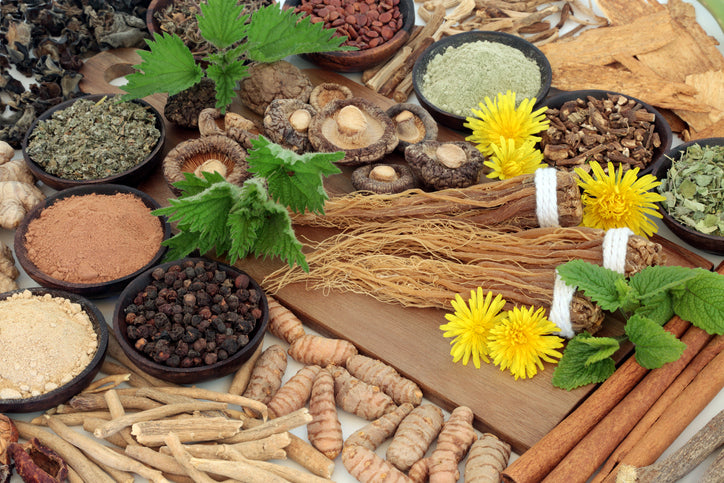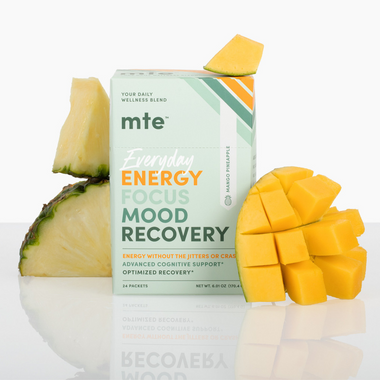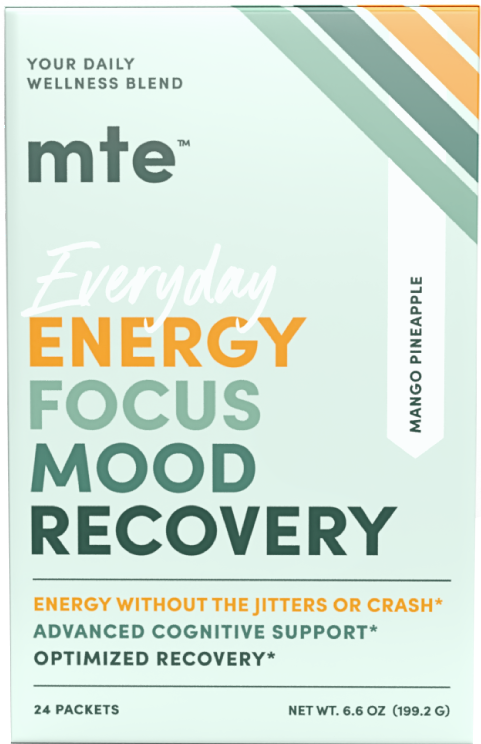
The Power of Superfoods & the Rise and Fall of the Multivitamin
We hear the term “superfood” all over the place – ads for nutritional meal plans, recommendations for diets, as powerhouse ingredients in wellness drinks. But what does it mean? And where did it come from? And is there any evidence describing a food as a superfood has any value besides that of marketability? We have questions.
As advocates of the holistic food and whole-body wellness movement, we’re proponents of incorporating superfoods into your daily life. One super-simple way to do it is a daily scoop of MTE's mix of greens powder, which doesn’t only contain superfoods, but adaptogens and nootropics as well. Raw ingredients – no chemicals or otherwise untoward components.
But back to superfoods.
What Does the Term “Superfood” Mean?
Some examples of superfoods are dark, leafy greens, dark berries, nuts, whole grains, yogurt, legumes, and fish, to name a few. If a food is jam-packed with good stuff our body needs to thrive, you can bet that someone, somewhere would classify it as a superfood. But seriously – what does it mean, though?
Unclear. In fact, official wisdom only puts forth another set of vagueries:
- From the Merriam-Webster Dictionary:
“A food (such as salmon, broccoli, or blueberries) that is rich in compounds (such as antioxidants, fiber, or fatty acids) considered beneficial to a person's health.”
- From the Cambridge Dictionary:
“A food that is considered to be very good for your health.”
- From the Oxford Learner’s Dictionary:
“A type of food that some people think is very good for you and helps to prevent disease.”
So that pretty much nails it down. Mystery over. We probably don’t even need the rest of this article…
Where Did the Idea of a Superfood Come From?
Merriam-Webster traces the first official use of the term “superfood” to 1915, but doesn’t give any details on the matter. However, this likely refers to the use of the term in an advertisement for bananas. As with all diet fads in the US, superfoods weren’t discovered; they were marketed.
So, yes, technically bananas were the first superfood. They were touted for being cheap, widely-available, highly-nutritious, beneficial to your health raw or cooked, and sanitarily-sealed in a peel. The United Fruit Company, who is said to have coined the term, even released two publications on the wonders of the banana.
Medical professionals took bananas and ran. Within a few years, doctors all over the country touted daily banana consumption as a preventative measure to celiac’s disease (We didn’t know about the whole gluten thing, yet). And so was born the first fad diet: the banana craze of WWI-era America.
Fast-forward to today and most medical professionals will tell you the term “superfood” is basically just a marketing strategy, but that the foods we do consider superfoods are inarguably really good things to include in a daily diet if you’re concerned with health and longevity.
WWII & the Rise of Food Quality Awareness in the US
At the time of the banana hysteria, there were only 3 facets of food people considered in this early view of nutrition: proteins, carbs and fats. Instead of pointing to poor nutrition for conditions we later found out were, in fact, caused by poor nutrition, people blamed lack of hygiene in food practices for pretty much all illness that couldn’t be directly linked to disease.
Interestingly enough, this obsession with cleaning foods – milling grains, polishing rice, sterilizing milk – took a bunch of the health benefits away from these foods:
- Grain processing destroyed the niacin in whole grains, leading to a higher incidence of pellagra, a B deficiency that causes sores and psychotic delusions.
- Grain processing also destroyed the thiamine in whole grains, leading to a higher incidence of beriberi, another B vitamin deficiency, but this one causes nerve damage that can eventually lead to paralysis.
- Milk sterilization murdered all the vitamin C in the milk, leading to higher incidences of scurvy. And this one even afflicted wealthy people, so, of course, the cause of all this new scurvy afflicting their children was a mystery. Money is nutritious, right?
The focus on the value of food changed in WWII. In 1941, the world was slipping into chaos. The shadow of war was slowly stretching its hands across the Pacific, and before the close of that year the US would be pulled into a long and devastating conflict. By 1942, nothing would look the same. For many, the war called for a change that would take them overseas to confront the evil directly while, for others, finding a way to survive the war had to be done through innovations at home. Some of these innovations remain with us today.
During this turbulent time in US history, nutrition, mass food production and transportable foods became necessities abroad and at home. M&M’s, for example, were invented during the war and initially sold only for soldiers in combat who needed transportable treats that wouldn’t ‘melt in your hand’.
Food rations led many to seek out quick, convenient meals which might satiate and make up for the lack of regular meals in these desperate times. This led to the birth of novel breakfast cereals that had hoped to add some well-needed celebration to the day as well as nutrition. It was in this same year that General Mills launched ‘CheeriOats’, later shortened to ‘Cheerios’.
The Rise of the Multivitamin
The idea of vitamins in WWII-era US wasn’t mainstream. In fact, the term “vitamin” had only been coined 3 years before the term “superfood,” in a scientific journal in 1912. It was used to describe foods with more than 3 nutrients.
However, as the marketing fiends we have always been, by the time the term “superfood” came on the scene a few years later, people had already created what were essentially multivitamin prototypes. The guy who wrote the initial vitamin article got religious about it and began to claim vitamins could cure diseases.
By 1922, several vitamin compound supplements, many of which were yeast-centered, strangely enough, were on the market, advertised as cure-alls for pretty much everything. We’re talking acne, nervous system disorders, brain fog, physical breakdowns, vigor, digestion, etc.
While some of these claims were extravagant, to put it nicely, others were true, and still are today (re: digestion, brain fog, vigor). By the early ‘30s, modern medicine had found a way to isolate and synthesize important vitamins and minerals, setting the stage for mass production of a superfood super-pill. Kind of.
Vitamins & Nutrients Take Center Stage in Wartime Survival
A lot happened with our view of food and nutrition in just the span of 1941-1943. To help with the lack of consistent meals for soldiers in the trenches, President Franklin D. Roosevelt called for the creation of the first set of ‘recommended daily allowances’ (RDA), which at the time consisted of six vitamins and two minerals. This was the world’s first one-a-day multivitamin, and it was born in 1943.
The idea behind a multivitamin was to provide necessary nutrients that were linked to deficiency diseases which soldiers might fall prey to during long-stretches of service. This had some history to draw from, as during the American Civil War there were over 30,000 cases of scurvy which is related to the lack of vitamin C consumption.
But today, these types of deficiency states are almost unheard of. In fact, many of the diseases that we deal with today, like cardiovascular disease and diabetes, are related to the over-consumption of food and the lack of physical activity due the demands of office work - something very different from the needs of World War II soldiers.
The idea that a multivitamin will protect us today in ways similar to that from 80 years ago is woefully out-of-date. Today, our mounting war is with our diet and lifestyle and it is being played out in our circulatory system and in the vulnerable recesses of our stressed-out minds.
While many of the innovations of the 1940’s certainly played a role in ending the war, virtually no-one would argue that they still play a significant role in our lives today. Except M&Ms, but those are gross.
Dietary Nutrition vs Swallowing a Multivitamin: Is one Better than the Other?
Just like processing food strips away its nutrition, synthesizing and stuffing isolated compounds into a pill compromises the bioavailability of said compounds. In fact, some recent science is now questioning the impact of the mighty multivitamin, even suggesting that whole foods may likely play a greater impact on our health than isolated nutrients. If you think about the whole of human history – that 100,000 years where we were totally okay without multivitamins – it seems a little… obvious, no?
In one exploration on in-situ nutrient consumption vs consuming an isolated compound, researchers from the University of Milan set out to find the difference between orange juice and vitamin C, and what they found out might surprise you.
The team gave test subjects either one glass of orange juice or a vitamin-C-fortified drink to consume. Both the orange juice and the vitamin-C drink had equal amounts of vitamin C (150mg) and as would be expected, when blood samples were taken both sets of study patients showed higher amounts of vitamin C in their blood.
However, when researchers exposed the study patient’s blood to a common chemical free-radical (a substance known to damage cellular DNA) the damage was significantly less in samples taken from volunteers who ingested orange juice, whereas, in the vitamin C only group, they noticed no protective effects.
The impact of this observation can’t be overstated, as scientific evidence is accumulating that many degenerative diseases have their origins in free-radical reactions. In fact, the list of conditions associated with uncontrolled free-radical damage includes heart health, joint function, respiratory wellness, blood sugar balance, vision health, and even brain function.
So, coming back around to superfoods: did the United Fruit Company have it right all along? Is eating a banana better than taking a potassium supplement? It sure looks that way.
Superfoods: Are They Vitamins 2.0?
Wait, wouldn’t superfoods actually be the OG vitamin? You know; since they didn’t have to be “discovered” and synthesized in a lab?
Semantics.
No one will deny that macronutrients like vitamins A, B, C…etc. play a significant role in human nutrition. And none of this is to say that the multivitamin movement was an illuminati-style snake oil conspiracy. The important development that’s leading us back to nutritious foods over supplements is how the body processes the compounds, and to what level the body actually gets to use all the vitamin A you consumed. Modern food science is beginning to find very strong indications that plants may also contribute to health and vitality through what are called ‘secondary metabolites’.
As we uncover and identify the important active ingredients in foods like ashwagandha, green tea and ginseng, we begin to understand why these foods have historical uses that predate our cute little multivitamins by 6000+ years. These lesser-known plant compounds don’t have the same popularity that vitamins have enjoyed, but their role in wellness cannot be overlooked.
Case Studies in Key Superfood Compounds
Consider the polyphenols found in green tea. They have been scientifically shown to be associated with several aspects of wellness, including longevity, balanced weight support, blood sugar management, and overall heart health. Do you know of a multivitamin that can say the same?
(Not-So-Fun Multivitamin Fact: Typical multivitamins have way more vitamin B that our body needs daily, and long-term overconsumption of vitamin B has been linked to liver damage, anemia and high blood sugar.)
Or how about the flavonoids found in the root vegetable called maca, which is a relative of broccoli and kale. It has been observed in clinical research to improve hormone profiles, lift mood, reduce stress, and improve mental performance. Which multivitamin has that on the label?
(More Multivitamin Maladies: Multivitamins typically contain at least 50% more vitamin A than you need daily. Overconsumption of vitamin A has been linked to increased risk of heart disease, lung cancer, and birth defects in the eyes, skull, heart, and lungs of a fetus.)
And how about the blue-green algae called spirulina that was once used by ancient Aztec long-distance runners for energy. It was even used by NASA as a nutrient-rich food source for traveling astronauts. It’s one of the richest sources of vegetarian protein and also contains several vitamins and minerals but scientists have also identified a unique protein called phycocyanin.
This compound found in spirulina has been shown to be a powerful antioxidant capable of supporting against inflammation and may even be particularly beneficial to brain health. It could even be the world’s first superfood, as its use dates back over a thousand years!
Why Consuming Nutrients via Plants is Better than Supplements
There are likely innumerable reasons getting your nutrition from your diet is better than from isolates made in a lab, but here are a few direct comparisons that highlight the stark differences between the ability of a multivitamin and the ability of a superfood:
Multivitamins
- often contain synthetic chemicals and binders that may have toxic effects on the body.
- are not a complete food source.
- usually contain incomplete nutrient isolates, often in excessive amounts that can be toxic to the body.
- are passed through the body without the majority being absorbed.
Superfoods
- often contain the complete spectrum of vitamins and nutrients we need
- can provide sustainable energy/vitality
- may aid in immunity
- contain beneficial phytonutrients
So, while the superfood movement is definitely a marketable wagon to ride, it’s not a meaningless hype word. Superfoods have been keeping our bodies healthy and happy for eons, and no pill can replicate that. The real mystery isn’t superfoods – it’s why in the world we’re just now rediscovering the benefits of nature.
It’s Time to Move Past the Multivitamin
Vitamins had their day in the sun, but it seems isolated vitamins cannot replace the inherent wellness offered in whole-foods nutrition. It’s time to make room for the promise of superfoods that aren’t defined by the obsolete limitations of macronutrients but rather celebrated for their clinical significance. Multivitamins served a great purpose in 1942 and kept diseases of deprivation away, but today’s superfoods aim at providing a sustainable form of energy that feeds both body and mind.
Superfoods are more than a multi. They have the potential to help restore cellular health and quite possibly even cellular wisdom, which is vitally important for longevity and quality of life. Locked within each human cell is the intelligence for self-healing, which is the most powerful medicine of all, and protecting that wisdom may be the power behind superfoods.






